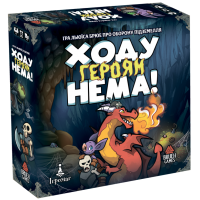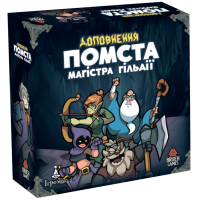Keep The Heroes Out Board Game Review
Related Products

In Keep The Heroes Out, like many other co-op games, you have to put out the fires all over the field until they spread and your brave heroes come to an end. However, in this case, you are the arsonist (if you are playing a certain monster), and the heroes are your enemies who are trying to clear your treasury.
Keep The Heroes Out is a deckbuilder in which you play mainly with a starting deck of 10 cards; adding more than 1-2 new cards to the deck is a rarity. And only representatives of the lower races need it; with real monsters (like a dragon) the deck works great from the start.
GAME PROCESS
Your monsters roam the dungeon, attack heroes, set traps, create items in certain rooms, and move those items to other rooms to exchange them for new cards and improve your deck.

After each turn of the monster clan (the faction controlled by the player), 2, 4 or 6 heroes are dropped into the dungeon rooms, depending on the difficulty level. They activate their abilities, move to rooms with chests and rummage through them. If the heroes surround your main treasury, then you lose.
Basically, heroes are wandering snacks that you need to eat (eliminate) between rounds. If they are allowed to accumulate, the situation will get out of control. The more heroes, the more dangerous they are, as freshly fired heroes activate already exhausted (like) heroes, and a snowball occurs. Each room of the dungeon has a small treasure chest that the heroes can get lost in (unless you breathe fire on them) if there are enough of them. When they are dissected, negative events are activated, the effects of which vary from "it doesn't matter" to "if you don't have a dragon, you've lost."
Players must optimally manage their actions. Which is better: move and attack the hero? Summon new monsters? Spend 4-5 action cards and add a new card to the deck, but lose the game (because you're not playing a dragon)? You will have to make difficult decisions (including when choosing monster clans).
Each turn you can risk and take 3 additional cards into your hand (a standard hand consists of 5 cards). If you are lucky, there are no consequences. If you're unlucky, you'll either get hurt a little (if things go well) or lose the game (if things don't go well).

PROS OF THE GAME
— Every turn you have to solve a new puzzle, and it's great. You usually draw 8 cards per turn + some effects allow you to draw additional cards. The moves are interesting, there is room for combinations and the feeling that you are a cool death machine (if you play as a dragon).

- The components are great. Meeples are not at all inferior to miniatures with their overproduction, only they are made of wood. They are big, strong and terribly cute. I like to touch them and look at them. Simply luxurious quality.
— There are 10 types (clans) of monsters in the game, each with its own style of play, which is significantly different. There is a great variety of strategies, and it is interesting to find synergies between clans.
- The game has 20 scenarios (plus alternate game modes), each with its own unique puzzle. This provides a lot of variety despite the non-random layout.

CONS OF THE GAME
- The game has good monsters (dragon) and bad monsters (most other clans). Weak and strong monsters can be taken in different combinations, and basically all of them can be played in all scenarios, but there are monsters that are always good and monsters that are always weak. Dragon is always the strongest monster with no options. Witches and slugs are always good too. Other monsters require more thoughtful planning and the arrival of certain cards. However, since the game is cooperative, perhaps the imbalance will not seem such a terrible disadvantage to you.
- He rages at random times. The effects of opening treasure chests range from "nothing happens" to "you lose due to a chain reaction". Also, when you put heroes in prison, the result varies from "you got rid of one hero and got cards, yay" to "you're probably going to lose now."
— The snowball effect works both against you and for you. If you're successful, you can afford to spend actions on deck upgrades and trap spam. Traps eliminate newly arrived heroes and free up your actions to spend on improving your deck... and so on. If things are not going well, then the heroes accumulate, activate each other and loot chests. When you rush ahead, sometimes you don't even have anything to do - there are extra cards in your hand.
- Moves are long. You have 5 cards, you almost always draw another 3. A total of 8 cards with 8 to 24 actions. For example, a dragon with a single potion will regularly draw 10+ cards, just like a monster queen. You will also spend a lot of time discussing plans. Downtime is great; This is the cost of moves with many combinations.

Ambiguous
— You will have to constantly count how many and which cards are left in the guild deck. The deck contains 4 cards for each of the hero classes—one room for each species—plus special cards unique to the scenario. At first there is complete randomness, but what follows is easier to guess what awaits you next. This information plays a key role; for example, "now you can safely throw heroes in prison, there are no mages left in the deck" or "these rooms no longer need to be defended: there are enough traps to kill the remaining heroes in the deck who sleep in these rooms."
— The gameplay is somewhat monotonous. After a few rounds, you'll find yourself doing the same thing all the time, only slightly changing your strategy depending on the current scenario. Apparently, the potential of the game was not fully realized, but in general the gameplay is quite good.
— The rules are not quite clearly laid out, which is clearly evident when you try to find an answer in the rule book, how to act in an ambiguous situation. Fortunately, the game is quite simple and such situations rarely arise.
CONCLUSIONS

Keep The Heroes Out is a fan game, period. Is it worth trying it out? In my opinion, yes. After all, you will be able to play as a dragon and... why play as someone else but a dragon?
The game is clearly not polished. Situations when you have nothing else to do and situations where you don't have enough actions to buy even one additional card are equally unpleasant. The only function of dungeon tiles is to generate you resources and exchange those resources for cards, which isn't very thematic. Some monster clans are very difficult to play effectively. In general, the game was a little underdeveloped, which is a pity; the result could be an even cooler cooperative.
Either way, Keep The Heroes Out has enough content, combos, difficulty levels, etc. to make the game worth the money. She is a fan - and it is worth trying. I'll give her an 8.5/10.






